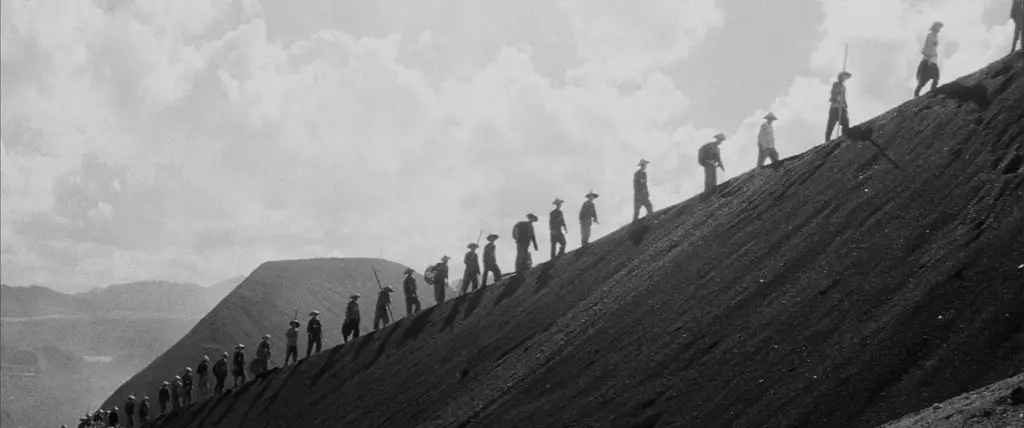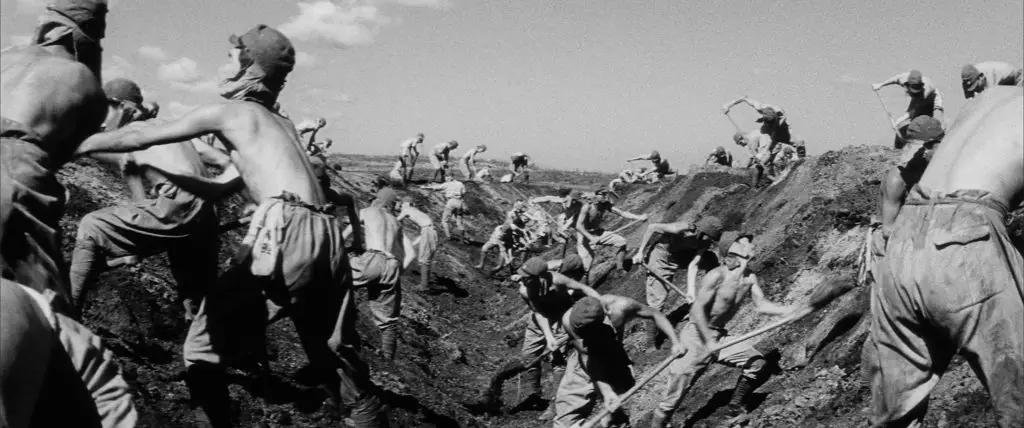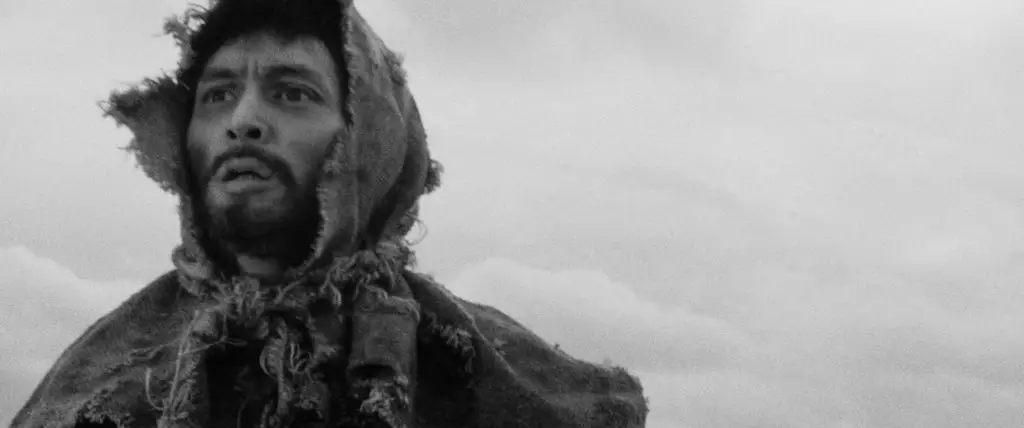The Human Situation (人間の條件, Ningen no jōken)
Director: Masaki Kobayashi
Written by: Masaki Kobayashi, Zenzo Matsuyama, Koichi Inagaki
Yr: 1959
Nation: Japan
Speaking about Rossellini’s Roma Citta Aperta, Godard mentioned, ‘Italy has regained the fitting of a nation to look itself within the face’. One wonders if the identical doesn’t maintain true for Japan and The Human Situation.
Regardless of its indictments of Japanese imperialism, the movie obtained a lot important and industrial acclaim again in 1959. In an interview, the lead actor Tatsuya Nakadai (Kaji) remembers how cinema halls can be offered out, even for the movie’s marathon viewings. Such wild crowds are certainly uncommon for a 9-hour movie that highlights the masochism of its folks. Nonetheless, the Allied occupation had introduced numerous publicity with it and cultural actions had began to thrive. Japan was experiencing a dramatic shift in social and political attitudes; a phenomenon that sits on the coronary heart of Kobayashi’s bleak, discursive rendering of the struggle. Very like Kaji, Kobayashi was a pacifist and socialist who needed to abandon his ethical leanings to combat within the Second World Struggle, and most Japanese audiences on the time resonated deeply with that expression.
“In the course of the filming, Kobayashi and Kaji have been principally one and the identical in my eyes. I feel the identical may very well be mentioned of the writer (of the supply novels), Gomikawa.” –Tatsuya Nakadai
Kaji is a well-intentioned Shakespearean idiot, preoccupied with delusions of novelty, continuously ignoring the nagging pragmatism. Within the first movie, he exudes the attribute naivety of a youthful reformer; within the second, he exalts the maturity and restraint of a righteous chief; within the third, he retreats inwards, slipping away from the chilly indifference of the world. From managing a camp to working in a single, the journey is structured to intensify the ironic contact of tragedy: Right here’s an idealistic messiah; right here’s a desolate man stripped to his primal wants.
The whole 9-hour work looks like a play completely staged in service of 1 function and one function solely: Open Japanese eyes to their fascist follies. Trauma brings down the resolute and weaklings alike. The reforms that appeared so fervently rapid, the liberty that bellowed restlessly, the gleaming fascist glory on the finish of the tunnel, all resemble the blurry portrait of a not too long ago deceased relative; although the portrait itself can’t be helped, one is persuaded to scrub the lenses. Nations typically appropriate their course after their delight comes up quick, however the final tragedy is that reflection comes afterwards, not earlier than the actual fact.
It’s a rational argument that anti-war movies would not have any bearing on the exhausting details of written historical past. However why ought to they? The promise of artwork lies not in political or institutional revolution however particular person liberation. One shouldn’t dwell on one’s misfortunes and wrongdoings however one shouldn’t shrink back from them both. One of many causes the movie has retained its emotional attraction through the years is that it balances its harsh introspective gaze with ample theatrical decision.

Except for its political and social significance for the Japanese, the movie serves as a cultural milestone in cinema’s evolution. Cinema has at all times gone hand in hand with literature however in its infancy, cinema was joined on the hip with theatre. Within the silent period, cinema took its cues virtually completely from theatre (pioneers of Italian Neorealism or painters like Bresson have been exceptions to the generic mould), then got here the Golden Period of Hollywood which emphasised theatrical melodrama over all else, and every thing else was just about in the identical vein. Nonetheless, the 50s proved to be the final refuge of overtly theatrical productions. Italian Neorealism had already introduced a hard-knocks mentality to movie, Hollywood was slowly operating out of steam, and within the subsequent decade, French New Wave would offer the blueprint for contemporary cinema, altering the very essence of how movies have been creatively approached. As such, The Human Situation stands because the final true epic of cinema’s theatrical epoch.
It’s ironic {that a} movie primarily involved with political disillusion will be so deluded in regards to the dynamics of the cultural panorama when particularly in Japan, the shape was quickly evolving by the hands of filmmakers like Akira Kurosawa, Yasujiro Ozu, and Kenji Mizoguchi. Within the early 50s (generally known as the Golden Age of Asian Cinema), Ozu was redefining cinematographic simplicity, Mizoguchi was exploring spacial dimensions in ways in which would change cinema eternally; within the neighbouring nation, Satyajit was receiving worldwide acclaim over his serene painterly observations of abject poverty.
So why did Kobayashi follow the melodramatic ruses of outdated? The director was used to creating movies for Shochiku Studio with social messages heavy-handedly pushed house utilizing stagey tropes. Shochiku was recognized for its shinpa melodramas (shinpa is a sort of Japanese theatre that made its means into cinema). The Human Situation —his first movie for Ninjin Membership, an unbiased movie firm— appears to be the pivot of his filmmaking profession.
“They (Ninjin Membership) didn’t desire a cinematographer in contract with the Shochiku. They wished the very best cinematographer in Japan, so we requested Miyajima.” –Masaki Kobayashi
Trying on the three movies, one finds Kobayashi going by a maturing part. One of many main causes for this, after all, is the work of cinematographer Yoshio Miyajima —this was their first collaboration— whose stark chiaroscuro visuals lend much-needed abstraction to the in any other case overbearing work. After The Human Situation, Kobayashi’s movies took on a nuanced solemnity, unfazed by trivia of exposition and serving to the viewers alongside. This shift in method is clear in his 1962 masterpiece Harakiri which occurs to be a lot shorter, a lot tighter, and on the similar time, gives a whole lot of respiration house.
“I used to be principally skilled beneath the Shochiku system which gave the director free reign. However making this movie with an unbiased manufacturing firm, made me notice for the primary time that it’s a collaborative effort involving the entire crew. My movies started to vary after that realization.” –Masaki Kobayashi

In 1960, Breathless launched the world to the fashionable pop movie and within the course of, freed cinema from the clutches of histrionic theatrics. Although theatre continued to affect the medium, by the early 60s, the cinematograph had began to forge a definite visible language. The final movie of the trilogy got here out in 1961 and although a high-end cultural wave was driving cinema in the direction of more energizing pastures, the mainstream audiences have been nonetheless liable to easier, straight-forward movies (they virtually at all times are).
Within the context of cultural innovation, one can not assist however scrutinize the Pandora field of the movie’s existence. It probes us to be pragmatic in our struggles, to regulate with the altering occasions, all of the whereas revering the old-school method that was diminishing on the time. Similar to its protagonist, it’s naively resolute in the direction of its ambitions even once they can’t be realistically arrived at. Not solely does it ignore the defective deserves of its beliefs, however it additionally goes on to denounce all that’s taking place round it. Think about a whining specimen of an historical species refusing to go extinct even when pure choice instructions it so! A futile protest certainly.
“Time may be very merciless. Just some movies survive.” –Bela Tarr
Upon reflection, it turns into clear how misplaced and credulous it truly is, similar to the Japanese in World Struggle II. One wonders if that contributes to the movie’s standing as a forgotten artefact. On the precipice of cinema’s well timed evolution, Kobayashi’s epic reveals us the trail not taken, a ultimate phrase on cinema’s potential as a perform of theatre.

References
The Human Situation I: No Larger Love. 1959. [film] Directed by M. Kobayashi. Japan: Ninjin Membership, Shochiku Studio.
The Human Situation II: Street to Eternity. 1959. [film] Directed by M. Kobayashi. Japan: Ninjin Membership, Shochiku Studio.
The Human Situation III: A Soldier’s Prayer. 1961. [film] Directed by M. Kobayashi. Japan: Ninjin Membership, Shochiku Studio.
[Interview by 992719643 767037177 M. Kobayashi]. (2017). Retrieved 2020, from https://www.youtube.com/watch?v=LL3R_K7X3k0
[Interview by 992731221 767043984 T. Nakadai]. (2017). Retrieved 2020, from https://www.youtube.com/watch?v=IUKjJpM9Fgo
Whyte, J., n.d. The Human Situation Blu-Ray Assessment | Cine Outsider. [online] Cineoutsider.com. Accessible at: <http://www.cineoutsider.com/opinions/bluray/h/human_condition_br.html> [Accessed 18 October 2020].



